Cotyledon Orbiculata (Pig Ear Succulent) Care & Propagation Tips
Written by Iris
Oct 19 2021
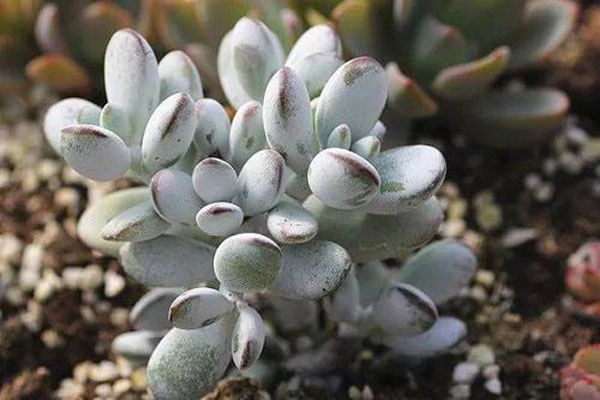
The origin of Cotyledon Orbiculata (Pig's Ear Succulent) is Namibia in southwest Africa. The leaves of the plant are spoon-shaped, and the plant is an upright succulent shrub that can grow taller. The tip of the leaf is purplish red with a tip, and there is a layer of white powder on the entire leaf surface. The tips and edges of the leaves will be reddish under strong light. Cotyledon Orbiculata blooms in early summer, the flowers are orange-red, and the buds look like small peppers hanging one by one.
The most important feature of a pot to consider is drainage. Well-draining soil will do no good if there’s nowhere for the water to drain. Drainage holes are necessary for keeping Cotyledon orbiculata happy and healthy.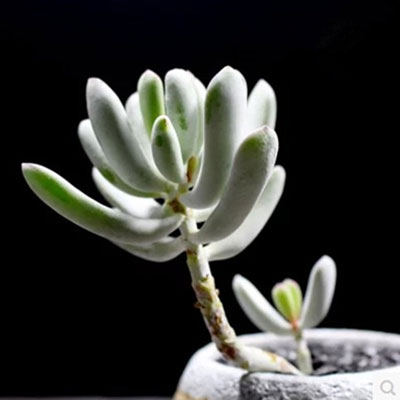
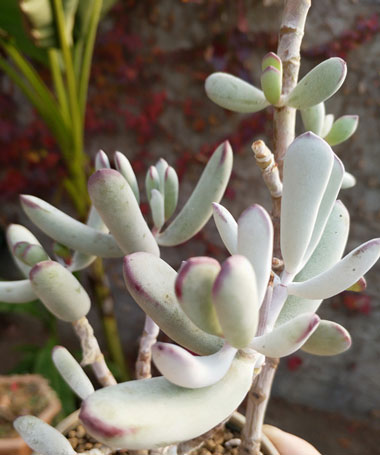
The humidity requirements for a Cotyledon Orbiculata are moderate, within the 50%-70% range. Too much humidity can lead to mold and rot.To keep the plant healthy, mist it with water regularly during the summer months or if its leaves start looking dry.
A balanced “slow-release” organic fertilizer is best, but a water-soluble fertilizer can also be used.
If you use a granular fertilizer, use half the normal dose because Cotyledon Orbiculata succulents don’t need much to grow and become leggy.
The most common pest that attacks the Pig’s ear succulent are mealybugs. Mealybugs secrete honeydew which may lead to sooty mold growth on plants, leaves, or even walls if left unchecked. To combat this issue, you can use neem oil or insecticidal soap.
Other pests that can attack Cotyledon orbiculata are spider mites, scale insects, and aphids. They often coexist with mealybugs. The best way to stop bugs from eating your plants is by using water and soap. This should be done every two weeks. To make sure the bugs are gone, you can also use a neem oil spray or horticultural oils to kill them. This should be done at least once a month for optimum results.
Other common problems faced by succulent plants are root rot and fungal issues due to overwatering. To combat this, you should thoroughly check your plant’s moisture levels at least once a week.
If it appears too wet or moist, you may need to allow more time between each watering session until the soil dries out completely before adding any more water again. If your Pig’s Ear succulent does not respond favorably to this, it may need repotting into a drier soil mix.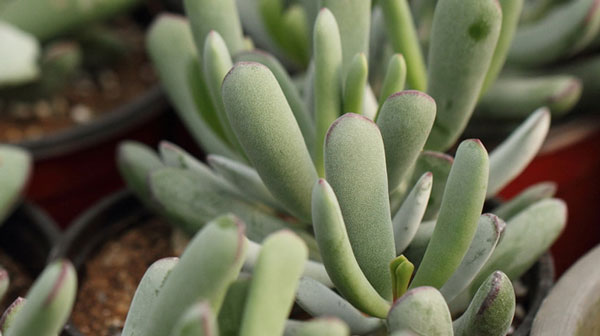
Cotyledon orbiculata var flanaganii: it’s a shrub native to South Africa that reaches 75 centimeters in height. Its leaves are arranged in a spiral, and are green-grey.
Cotyledon orbiculata var oblong: it is a bush that grows in South Africa and Swaziland. Its leaves are thin and flattened, of a grayish-green color.
Cotyledon orbiculata var oophylla: it is a shrub native to South Africa. Its leaves are smaller than those of the type species, acquire an oval shape, and usually do not exceed 25 centimeters in height.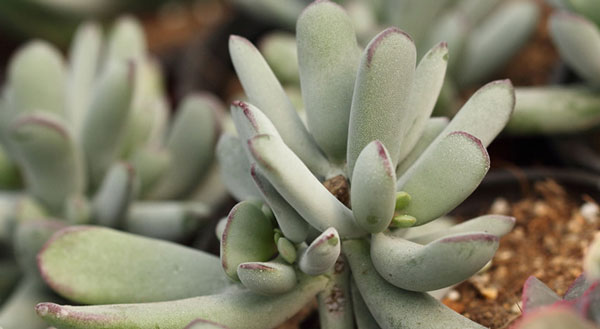
Where to Grow Cotyledon OrbiculataHow to Propagate Cotyledon OrbiculataCotyledon Orbiculata Propagation with SeedsCotyledon Orbiculata Propagation with Stem CuttingsCotyledon Orbiculata Propagation with Leaf CuttingsHow to Care for Cotyledon OrbiculataCotyledon Orbiculata LightingCotyledon Orbiculata Soil CareCotyledon Orbiculata WateringCotyledon Orbiculata Temperature & Humidity CareCotyledon Orbiculata Fertilizer CareCotyledon Orbiculata Pruning CareCotyledon Orbiculata Pests & Diseases CareVarieties of Cotyledon Orbiculata (Pig's Ear Succulent) Is the Cotyledon Orbiculata (Pig's Ear Succulent) Toxic?
Where to Grow Cotyledon Orbiculata
Most species of Cotyledon Orbiculata are quite adaptable and can grow in most types of container. Plastic, ceramic, and terra cotta pots are all good choices, and most gardeners have a preference. As long as their needs are met, Cotyledon can grow anywhere.The most important feature of a pot to consider is drainage. Well-draining soil will do no good if there’s nowhere for the water to drain. Drainage holes are necessary for keeping Cotyledon orbiculata happy and healthy.

How to Propagate Cotyledon Orbiculata
Cotyledon Orbiculata can be propagated by leaves, cuttings or seeds.Cotyledon Orbiculata Propagation with Seeds
This succulent type Cotyledon Orbiculata (Pig's Ear Succulent) is a slow grower so even if it can be propagated by its seeds, this method is not recommended. To propagate from the seeds, plant the seeds in a well-draining soil mixture. This method can be used outdoors. In cooler areas, indoor propagating is recommended.Cotyledon Orbiculata Propagation with Stem Cuttings
When propagating cotyledon orbiculata from cuttings, cut a leaf from the mother plant carefully with a clean knife or scissors. Before replanting, wait for a few days to allow it to callous. Use well-draining soil for your new succulent plant. Don't forget to water when the soil dries out.Cotyledon Orbiculata Propagation with Leaf Cuttings
When propagating Cotyledon Orbiculata with leaves. You should get a leave carefully from the mother plant. It should be a healthy leave that has no part left on the stem. In this way, the propagation will work. Before replanting, wait for a few days to allow it to callous. Use well-draining soil for your new succulent plant. Don't forget to water when the soil dries out.
How to Care for Cotyledon Orbiculata
Cotyledon Orbiculata Lighting
Cotyledon Orbiculata is a sunlight lover. It is a huge favor by allowing it several hours in the sun per day. For indoors, place it near a sunlit window. If you’re growing it outdoors, make sure it’s set at a well-lit spot with the possibility of a partial shade sometime during the day; the summer heat can get overwhelming.Cotyledon Orbiculata Soil Care
Cotyledon Orbiculata prefer well-draining soil with a mineral content of between 70% and 80%. Water retaining materials like clay and peat moss should be avoided as they may make the soil too soggy and cause the roots to rot. Soil formulated for cacti and other succulents is ideal for Cotyledon Orbiculata. Whether you prefer a commercial soil mix or making your own, make sure it drains properly.Cotyledon Orbiculata Watering
Remember we're talking about a succulent here – and thrives in mostly dry conditions in the wild. So the occasional watering Cotyledon Orbiculata will serve the plant just fine. As a rule, always hold back on giving your pig’s ear a drink until the soil has dried out. This can take anywhere from 1-2 weeks – depends on where you live. Be thorough with the watering whenever you do it. During your sessions, only stop when the water flows out through the bottom of the container.Cotyledon Orbiculata Temperature & Humidity Care
Cotyledon Orbiculata plants thrive in warm temperatures of at least 70 degrees Fahrenheit (21 degrees Celsius) during the day. Still, they require a lower nighttime temperature of 60-65 F (16-18 C). Cotyledon Orbiculata is tolerant of temperature fluctuations as long as they’re not too drastic (i.e., below freezing at night). If you live in a cooler climate without daytime temperatures above 70 F (21 C), grow Cotyledon Orbiculata indoors, where they can be given direct light from artificial lamps during the day. This way, their lower nighttime temperatures will fall within acceptable ranges.The humidity requirements for a Cotyledon Orbiculata are moderate, within the 50%-70% range. Too much humidity can lead to mold and rot.To keep the plant healthy, mist it with water regularly during the summer months or if its leaves start looking dry.
Cotyledon Orbiculata Fertilizer Care
Pig's ear succulents are not heavy feeders and do well with a light feeding once or twice a year. The best time to fertilize is in late spring or early summer.A balanced “slow-release” organic fertilizer is best, but a water-soluble fertilizer can also be used.
If you use a granular fertilizer, use half the normal dose because Cotyledon Orbiculata succulents don’t need much to grow and become leggy.
Cotyledon Orbiculata Pruning Care
Pruning Cotyledon Orbiculata will mainly entail cutting off shriveled blooms. When left on, they’re going to clamp down on the growth of your plant considerably. All you need is a pair of sharp scissors. Make sure to cut off as much of the stalk as possible. When some branches do not have a good appearance or are too old, you can prune, ideally in spring, after flowering. The best is to cut by hand by breaking the stems gently. Be sure to keep 3 to 5 leaves on each branch, as this may weaken it too much.Cotyledon Orbiculata Pests & Diseases Care
The Cotyledon orbiculata is a tough plant, but it can succumb to pests and diseases.The most common pest that attacks the Pig’s ear succulent are mealybugs. Mealybugs secrete honeydew which may lead to sooty mold growth on plants, leaves, or even walls if left unchecked. To combat this issue, you can use neem oil or insecticidal soap.
Other pests that can attack Cotyledon orbiculata are spider mites, scale insects, and aphids. They often coexist with mealybugs. The best way to stop bugs from eating your plants is by using water and soap. This should be done every two weeks. To make sure the bugs are gone, you can also use a neem oil spray or horticultural oils to kill them. This should be done at least once a month for optimum results.
Other common problems faced by succulent plants are root rot and fungal issues due to overwatering. To combat this, you should thoroughly check your plant’s moisture levels at least once a week.
If it appears too wet or moist, you may need to allow more time between each watering session until the soil dries out completely before adding any more water again. If your Pig’s Ear succulent does not respond favorably to this, it may need repotting into a drier soil mix.

Varieties of Cotyledon Orbiculata (Pig's Ear Succulent)
It is a very variable succulent, so much so that there are some that you may find difficult to make a real Cotyledon orbiculata. Let’s see what they are:Cotyledon orbiculata var flanaganii: it’s a shrub native to South Africa that reaches 75 centimeters in height. Its leaves are arranged in a spiral, and are green-grey.
Cotyledon orbiculata var oblong: it is a bush that grows in South Africa and Swaziland. Its leaves are thin and flattened, of a grayish-green color.
Cotyledon orbiculata var oophylla: it is a shrub native to South Africa. Its leaves are smaller than those of the type species, acquire an oval shape, and usually do not exceed 25 centimeters in height.

Is the Cotyledon Orbiculata (Pig's Ear Succulent) Toxic?
The Cotyledon orbiculata is not toxic to humans and has some medicinal uses.The leaves are often used as a poultice, which is often applied to warts and corns in South Africa. The leaves are also used for boils or skin ulcers in other areas where the plant grows. However, the Cotyledon orbiculata is considered toxic to cattle, dogs, and other animals. It can trigger a condition in animals known as cotyledonosis. Since Cotyledon orbiculata plants are toxic for these types of mammals, you must keep them away from your pets at all times.Latest Updated
- Benefits of Bugleweed - 7 Science-backed Health Benefits
- Bugleweed Dangers & Side Effects - Is It Poisonous?
- How to Plant Evergreen Trees - What You Should Know
- When to Plant Evergreens - Grow Guide for Evergreen Trees
- 12 Wonderful Evergreen Shrubs for Your Garden
- 12 Popular Evergreen Plants with Pictures for Beginners
- When And How To Prune A Lilac Bush Like a Pro
- How to Grow & Care for Lilac Vine (Hardenbergia Violacea)
- Japanese Lilac Tree (Syringa Reticulata) Care & Propagation Guide
- Shumard Oak Pros and Cons - What to Know
Popular Articles
- Winter maintenance of Antirrhinum Majus
- How to Grow Terminalia Mantaly Tree
- How to Grow and Care for Crossostephium Chinense
- How to grow Antirrhinum Majus in spring
- Peristeria Elata (Dove Orchid) Profile: Info & Care Guide
- Underwatered Snake Plant (Sansevieria Trifasciata) - Signs And How To Fix
- How to Care for Brazilian Jasmine Plant (Mandevilla Sanderi)
- How to Grow & Care for Graptopetalum Purple Delight in Summer
- Rosa Chinensis (China Rose): Plant Growing & Care Tips
- How to Care for Baby Sun Rose (Aptenia Cordifolia)